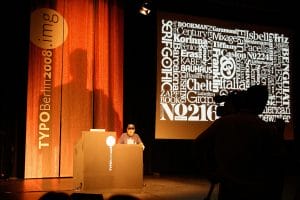Born in Brooklyn, Benguiat’s father was a designer. Benguiat wanted to fight in World War II, but wasn’t old enough — so his father helped him forge a birth certificate, and Ed joined the U.S. Army Air Forces, where he was a radio operator on bombers, and later did photo reconnaissance. After the war he played the drums in jazz bands with Stan Kenton and Woody Herman. But something happened to change his career path. “I’m really a musician, a jazz percussionist,” he told an interviewer. “One day I went to the musician’s union to pay dues and I saw all these old people who were playing bar mitzvahs and Greek weddings. It occurred to me that one day that’s going to be me, so I decided to become an illustrator.”
His first job: “cleavage retoucher” for films, covering up for actresses showing too much, which might violate the “Hays Code” censorship laws. He used his G.I. Bill education benefits to study graphical design, calligraphy, and typography at the Workshop School of Advertising Art. Benguiat (pronounced ben-GAT) also designed or redesigned logos, especially those based on typography: Esquire, The New York Times, Playboy, McCall’s, Reader’s Digest, Look, Sports Illustrated, The Star-Ledger, The San Diego Tribune, AT&T, Coke, Estée Lauder, Ford, and many others. He also designed titles for films, such as the original Planet of the Apes, Super Fly, and The Guns of Navarone.

But he’ll be best known for creating font faces. Few people knew what they were and the artistry behind them until computers took over typesetting. It matched his earlier career: “A letterform is like music,” he said. “It’s got to carry a tune … have balance.” His first font, Norma Script, which he named after his wife, was quickly bought by the Photo Lettering Inc. type house, which later merged into the International Typeface Corp., or ITC. His next font, Johnnie, named for his son, was commissioned by the Ford Motor Co. He also modernized older font designs, such as Bookman and Souvenir. In all, ITC released more than 600 of Benguiat’s font designs, including the eponymous ITC Benguiat, which in the days before computers took him a year and a half to draw, and Benguiat Gothic. As for his fonts being available to pretty much any computer user today, he said “the computer is only as good as the person behind it.” Ephram Edward Benguiat died from cancer at his home in New Jersey on October 15. He was 92.
